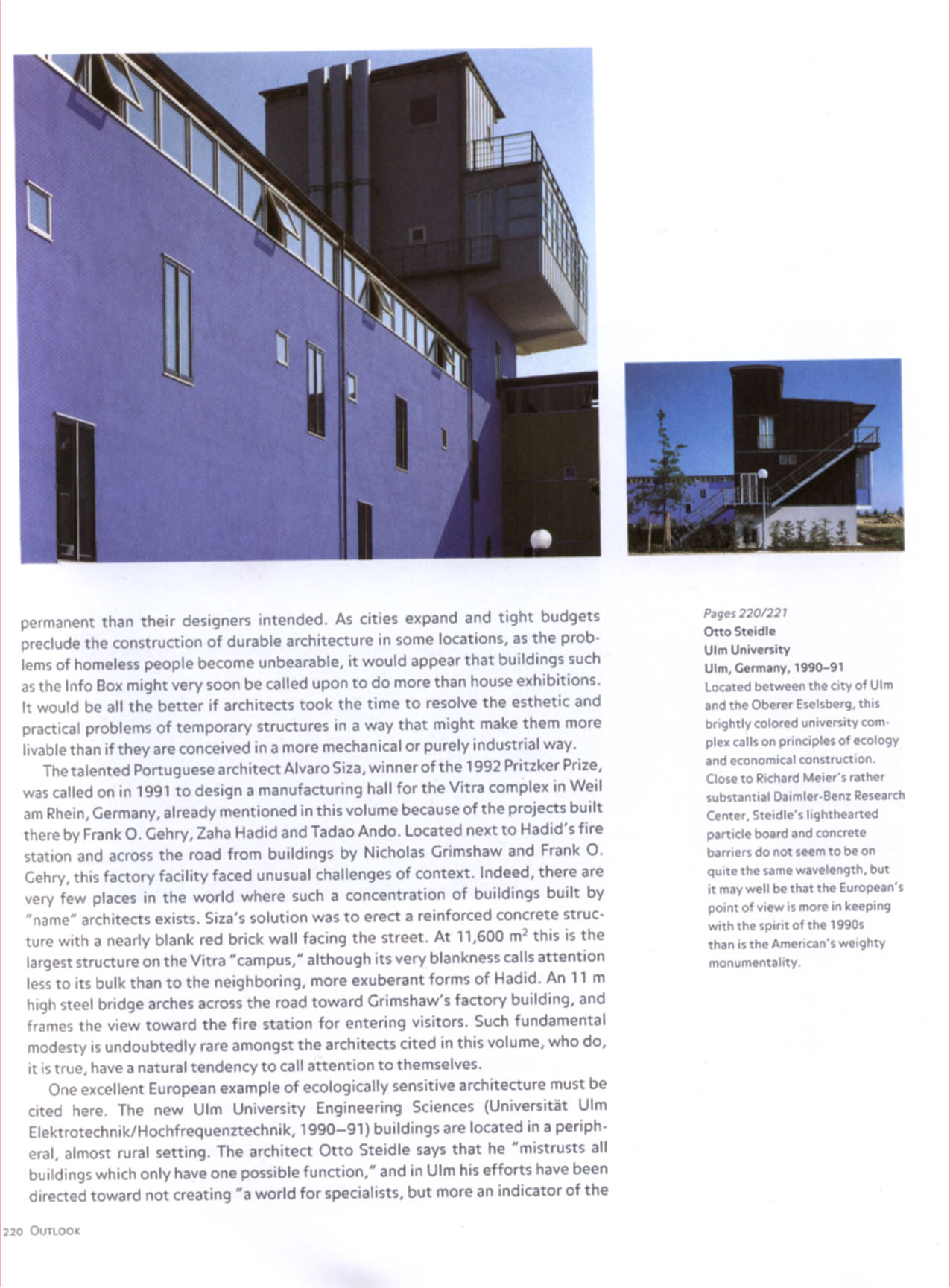New Forms Taschen 208


permanent than their designers intended. As cities expand and tight budgets preclude the construction of durable architeaure in some locations, as the prób-lems of homeless people become unbearable, it would appear that buitdings such as the Info Box might very soon be called upon to do morę than house exhibitions. It would be all the better if architeas took the time to resolve the esthetic and practical problems of temporary struaures in a way that might make them morę livable than if they are conceived in a morę mechanical or purely industrial way.
The talented Portuguese architea Alvaro Siza, winner of the 1992 Pritzker Prize, was called on in 1991 to design a manufacturing hall for the Vitra complex in Weil am Rhein, Germany, already mentioned in this volume because of the projeas built there by Frank O. Gehry, Zaha Hadid and Tadao Ando. Located next to Hadid's fire station and across the road from buildings by Nicholas Grimshaw and Frank O. Gehry, this factory facility faced unusual challenges of context. Indeed, there are very few places in the world where such a concentration of buildings built by "name" architects exists. Siza's solution was to erect a reinforced concrete struć-turę with a nearly blank red brick wali facing the Street. At 11,600 mJ this is the largest structure on the Vitra 'campus," although its very blankness calls attention less to its bulk than to the neighboring, morę exuberant forms of Hadid. An 11 m high Steel bridge arches across the road toward Grimshaw's factory building, and frames the view toward the fire station for entering visitors. Such fundamental modesty is undoubtedly rare amongst the architeas cited in this volume, who do, it is true, have a natural tendency to cali attention to themselves.
One excellent European example of ecologically sensitive architeaure must be cited here. The new Ulm University Engineering Sciences (Universitat Ulm Elektrotechnik/Hochfrequenztechnik, 1990-91) buildings are located in a periph-eral, almost rural setting. The architea Otto Steidle says that he "mistrusts all buildings which only have one possible funaion," and in Ulm his efforts have been direaed toward not creating "a world for specialists, but morę an indicator of the
2 JO Outlook
P»get 220/221 Otto Steidle Ulm Univer$ity Ulm, Germany, 1990-91 Located between the city of Ulm and the Oberer Eseisbcrg, this bnghtly colored university com-plex calls on principles of ecology and economical construction. Close to Richard Meier's rather substantial Daimler-Benz Research Center, Steidle's lighthcartcd particie board and concrete barriers do not seem to be on quite the same wavelength. but it may well be that the European's point of vicw is morę in keeping with the spirit of the 1990$ than is the Amencan's weighty monumentality.
Wyszukiwarka
Podobne podstrony:
New Forms Taschen 044 Toyo Ito Shimosuwa Lakę Suwa Museum Shimosuwa-machi, Nagano, Japan, 1990-
New Forms Taschen 043 Toyo Ito Shimosuwa Lakę Suwa Museum Shimosuwa-machi, Nagano, Japan, 1990-
New Forms Taschen 199 Ptges 210/211 Erick van Egcraat Natiooalc Nederlanden and INC Bank B
New Forms Taschen 126 Rafael ViAoly Tokyo International Forum Tokyo. Japan, 1989-96 located dos
New Forms Taschen 182 Pight Frank O. Cchry Edgemar Comple* Vemc*. Califomia, 1985-87 Located just do
New Forms Taschen 008 One of Frank O. Gehry s morę successful buildings is his Vitra Design Museum i
New Forms Taschen 190 Samitaur in Culver City challenges the use of urban space in a slightly differ
więcej podobnych podstron